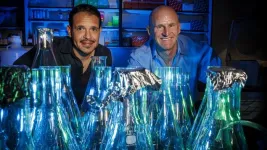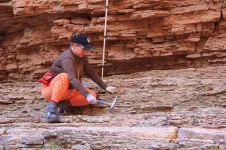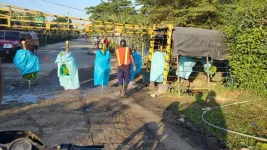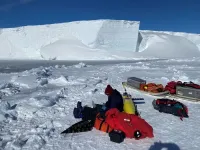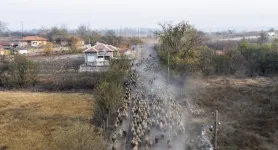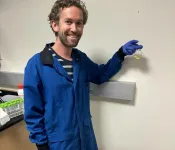(Press-News.org)
Teams of mountaineering mice are helping advance understanding into how evolutionary adaptation to localized conditions can enable a single species to thrive across diverse environments.
In a study led by Naim Bautista, a postdoctoral researcher in Jay Storz’s lab at the University of Nebraska–Lincoln, the team took highland deer mice and their lowland cousins on a simulated ascent to 6,000 meters. The “climb” ventured from sea level and the mice reached the simulated summit seven weeks later. Along the way, Bautista tracked how the mice responded to cold stress at progressively lower oxygen levels.
“Deer mice have the broadest environmental range of any North American mammal, as they are distributed from the plains of Nebraska to the summits of the highest peaks in the Rocky Mountains and Sierra Nevada,” said Storz, Willa Cather Professor of biological sciences. “This study tested whether they are able to thrive across such a broad range of elevations by evolving adaptations to local conditions or by possessing a generalized ability to acclimatize.”
Conducted in a specialized lab at Canada’s McMaster University, the study divided each team of highland and lowland mice into two distinct groups — a control that remained at sea level throughout the study, and an acclimation group that embarked on the seven-week ascent.
After seven days at sea-level, conditions for the acclimated group advanced by 1,000 meters in elevation weekly, with oxygen levels reduced to reflect what climbers would experience. The research team monitored the ability of each mouse to cope with cold exposure by means of metabolic heat production.
Data showed that the highland and lowland deer mouse cousins do not share a general ability to acclimate to hypoxia (low oxygen conditions). As the simulated elevations rose above 4,000 meters, the homefield advantage of the highland mice quickly became apparent. As oxygen levels dropped, the highland mice were better able to regulate body temperature than their lowland counterparts owing to more efficient breathing and circulatory oxygen-transport.
“The results show us that the highlanders and lowlanders do not share a generalized ability to acclimatize to changing environmental conditions,” Bautista said. “Rather, the mice living at higher elevations share evolved ways to acclimatize to low oxygen conditions that are distinct from those of the lowland prairie mice.”
The study also showed that the highland mice have a genetic advantage that helps suppress thickening of the right ventricle of the heart, a symptom of pulmonary hypertension, which is a common malady among lowland mammals that are forced to acclimatize to low oxygen conditions.
Bautista said the findings show how adaptation to local conditions can allow a widely distributed species like the deer mouse to thrive in diverse environments.
“It highlights how evolved changes specific to populations help shape their flexibility,” Bautista said. “Ultimately, it is these changes that influence their ability to survive within different habitats.”
Bautista is finalizing plans to repeat the study, taking it to new heights by measuring the responses of the yellow-rumped leaf-eared mouse, the world’s highest-dwelling mammal. The species hails from the Andes mountains, living at elevations up to 22,110 feet, and was discovered by Storz.
The deer mice study was recently published in PNAS. Other members of the research team include Storz; Ellen Shadowitz and Graham Scott of McMaster University; Nathanael Herrera and Zachary Cheviron of the University of Montana; and Oliver Wearing of the University of British Columbia.
END
LOGAN, UTAH, USA – Any boomer, gen xer, millennial, gen zer or alpha who’s studied geology has likely gained foundational knowledge from Edwin Dinwiddie McKee’s landmark studies of the Grand Canyon’s sedimentary record – even if they don’t readily recognize McKee’s name.
The legendary scientist, who lived from 1906-1984, studied and documented the stratigraphy and sedimentation of Colorado Plateau geology, especially the Grand Canyon’s Cambrian Tonto Group, for more than 50 years. His time-tested ...
A Michigan State University researcher’s new model for studying breast cancer could help scientists better understand why and where cancer metastasizes.
Professor https://directory.natsci.msu.edu/Directory/Profiles/Person/103559 who teaches in the MSU Department of Physiology, has been researching the E2F5 gene, of which little is known, and its role in the development of breast cancer. Based on findings from Andrechek’s lab, the loss of E2F5 results in altered regulation of Cyclin D1, a protein linked to metastatic breast tumors after long ...
AUSTIN, Texas — Friends and distinguished alumni of the McCombs School of Business at The University of Texas at Austin inducted four alumni into the school’s Hall of Fame on Nov. 7 at the AT&T Hotel and Conference Center. This year’s honorees are Christopher Bake, BBA ’88; Ray Brimble, B.A. ’74; Bennett Glazer, BBA ’68; and Brien Smith, BBA ’79, MPA '81. McCombs Dean Lillian Mills also recognized 2024 Rising Stars Simeon Bochev, MSF ’13; Michael Ginnings, BBA ’09; and Gerardo Guardado, MBA ’10.
The ...
There’s no cure for a fungal disease that could potentially wipe out much of global banana production. Widespread adoption of cement paths, disinfection stations, and production strategies could net 3-4 USD of benefits for each dollar invested in Colombia.
Hundreds of millions of dollars in banana exports from Colombia are at risk due to a fungal disease best known as Tropical Race 4 (TR4). First detected in Asia in the 1990s, the Fusarium fungus that causes the disease arrived in Colombia in 2019, completing its inevitable global spread to South America, the last major banana production continent that remained TR4-free. Researchers are confident ...
New research reveals for the first time how a major Antarctic ice shelf has been subjected to increased melting by warming ocean waters over the last four decades.
Scientists from the University of East Anglia (UEA) say the study - the result of their autonomous Seaglider getting accidentally stuck underneath the Ross Ice Shelf - suggests this will likely only increase further as climate change drives continued ocean warming.
The glider, named Marlin, was deployed in December 2022 into the Ross Sea from the edge of the sea ice. Carrying a range of sensors to collect data on ocean processes that are important for climate, it was programmed to travel northward into ...
Navigating the intersection of alcohol use and intimate partner violence amongst young couples is not an easy journey, and for bisexual+ couples, the road may be even more winding.
“No study has examined the extent to which alcohol use increases intimate personal violence among bisexual+ young adults or daily experiences unique to them. Our study will look at factors such as minority stressors that may lead to alcohol-related partner violence,” said Meagan Brem, director of the Research for Alcohol and Couple’s Health Lab at Virginia Tech.
Alcohol use and intimate partner violence - defined as any action in a ...
A Branco Weiss Fellowship – Society in Science has been awarded to Dr Gergana Daskalova. The fellowship funds Daskalova’s research project “Biodiversity change amidst disappearing human traditions and changing socio-economics”. She joins the Department of Conservation Biology at the University of Göttingen to work together with Professor Johannes Kamp. The five-year fellowship, which is worth over €530,000, will enable Daskalova to investigate the ecological and human fingerprints of land abandonment. Considering the question from both a local and a global perspective, Daskalova’s research will reveal what happens to nature when people leave, ...
Junior Professor Johannes Walker, University of Göttingen, has been awarded an Exploration Grant from the Boehringer Ingelheim Foundation. Walker teaches and carries out research at the Institute for Organic and Biomolecular Chemistry. The award of 180,000 euros will enable Walker and his team to develop new approaches to synthesizing new compounds.
“The aim of our project is to develop new strategies for the synthesis of a particular group of new chemical compounds,’ Walker explains. These compounds are called saturated polycyclic molecules. They are structurally complex ...
A new EU joint research project led by the University of Göttingen will explore how migration, demographic change and current crises are affecting social cohesion and democratic structures in Europe. A key objective is to find out how resilient democratic structures can strengthen local communities in times of profound demographic change. The project “Identities - Migration - Democracy (We-ID)” has been awarded funding of around three million euros over three years by the European Union.
European societies are undergoing a profound demographic transformation: falling birth rates, rising life expectancy and migration are increasingly ...
UC Santa Cruz chemists have discovered a new way to produce biodiesel from waste oil that both simplifies the process and requires relatively mild heat. This discovery has the potential to make the alternative fuel source much more appealing to the massive industrial sectors that are the backbone of the nation’s economy.
In 2022, the U.S. transportation sector alone used about 3 million barrels of diesel per day, accounting for about 75% of total consumption of the fuel in this country. That same year, ...
